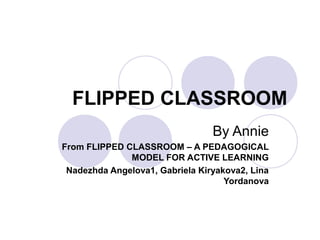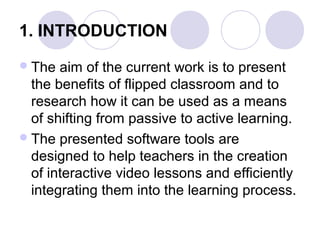Flipped classroom
- 1. FLIPPED CLASSROOM By Annie From FLIPPED CLASSROOM ĻC A PEDAGOGICAL MODEL FOR ACTIVE LEARNING Nadezhda Angelova1, Gabriela Kiryakova2, Lina Yordanova
- 2. Abstract ? The development of the information and communication technologies provides opportunities for implementation of new pedagogical models and approaches in education. These models allow students to participate actively in the learning process - interact and collaborate with other students and teachers. The aim of the current work is to present the benefits of one of the forms of blended learning - flipped classroom and to research how it can be used as a means of shifting from passive to active learning.
- 3. 1. INTRODUCTION ?The aim of the current work is to present the benefits of flipped classroom and to research how it can be used as a means of shifting from passive to active learning. ?The presented software tools are designed to help teachers in the creation of interactive video lessons and efficiently integrating them into the learning process.
- 4. 2. NATURE OF THE FLIPPED CLASSROOM MODEL ?2.1. Active learning methods ?2.2. Advantages and disadvantages of the model ?2.2.1. Benefits ?2.2.2. Limitations ?2.2.3. Important requirements for successful application of the model
- 5. 3. OUR EXPERIENCE ?3.1. Just-in-time teaching ?3.2. QR codes ?3.3. Screen casting
- 6. 4. FREE SOFTWARE TOOLS FOR CREATING LESSONS SUITABLE FOR FLIPPED CLASSROOM MODEL ? EduCanon ? Teachem ? VideoNotes ? Bluebbr ? Zaption ? EdPuzzle ? BlendSpaces
- 7. 5. CONCLUSIONS ? In general most students prefer video lectures comparing with traditional way of teaching ĻC 68%. ? There is a small group of students who do not like to watch videos ĻC they are getting tired, not able to concentrate, prefer to listen to the speaker and others. We think these students are persons that do not like changes in general and they are afraid of taking responsibility.







